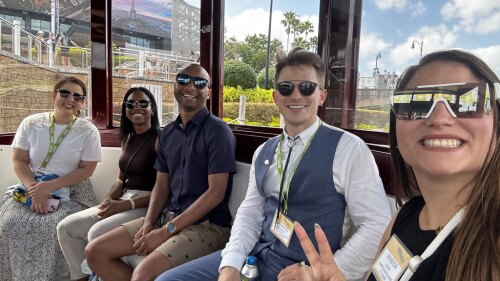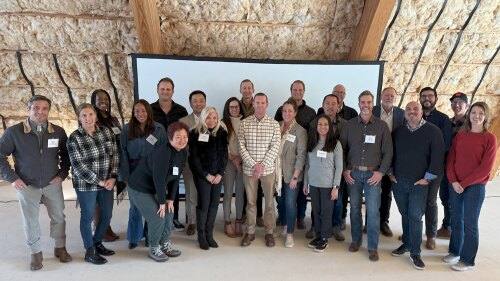At its essence, retrofitting suburbs is about transforming strip malls, sprawling subdivisions, big-box stores, and all the other spaces that Ellen Dunham-Jones calls “prototypical suburban property types” into more livable and sustainable places.
“[The suburbs] were wonderful places when they were being built, and they helped a lot of generations of families achieve terrific quality of life,” Dunham-Jones told ULI members gathered for the inaugural ULI Toronto Emerging Trends and City Building Fall Symposium, held at the Metro Toronto Convention Centre.
“But now after 50 years, we see an enormous list of unintended consequences.”
Dunham-Jones, professor of architecture at the Georgia Institute of Technology, gained prominence for a 2010 TED Talk that addressed the challenges and opportunities posed by suburban redevelopment. The talk highlighted themes discussed in her 2008 book, Retrofitting Suburbia: Urban Design Solutions for Redesigning Suburbs, which have continued to resonate across a wider audience within the real estate industry.
The following are three major themes that revolve around suburban retrofitting that she addressed during her talk at the ULI Toronto symposium.
Decreasing Car Dependence in the Age of Driverless Cars
Dunham-Jones described automobile dependence as the top challenge that she and coauthor June Williamson, professor of architecture at the City University of New York, were aiming to address when they published Retrofitting Suburbia. Moving away from car dependence is the “challenge the suburbs were never built for,” she told the crowd.
One example of building urbanism on top of parking lots is Mashpee Commons in Massachusetts, the oldest suburban retrofit that Dunham-Jones and Williamson found in their research. There, over the course of 20 years, a mixed-use, walkable New England village was built on the site of a former strip shopping center.
An example of a fine-grain strategy to reduce auto dependence is to introduce a small amount of retail space into residential neighborhoods. Dunham-Jones presented an example of a Nashville neighborhood where a residential lot was used to house eight units of micro-retail space, each measuring less than 400 square feet (37 sq m). Projects such as this “give people a reason to walk around their neighborhoods,” she said.
Turning to the future, Dunham-Jones was unsure of how the advent of driverless cars—a recurring topic at the ULI Toronto symposium—would affect automobile dependence. “Are driverless cars going to extend sprawl and make it easier for people to commute farther and farther away, or [are they] going to have the opposite effect?” she asked, noting that a lot of speculation is happening on both sides.
One PwC analysis she cited made the prediction that the U.S. fleet of cars will contract from 254 million to 2.4 million, a factor of 100. In this scenario, there will be far fewer cars on the road and they will not be privately owned. “It will essentially be Uber with driverless cars,” she said.
Grappling with the Unintended Consequences of Suburbanization
While reducing automobile reliance remains “job number one,” Dunham-Jones said that a desire exists to use retrofitting as an opportunity to identify solutions to other problems that have manifested as unintended consequences of suburbanization.
One of the chief challenges is tackling the adverse effects that the suburban lifestyle has had on public health. For years, the suburbs had been marketed as a healthy place to raise a family, Dunham-Jones explained. This perception, however, is antiquated. While the major health threat during the 20th century was considered to be infectious diseases thriving in overcrowded cities, the consequence of the low-density, car-dependent suburban lifestyle has been the alarming rise in the prevalence of chronic diseases like diabetes and heart disease spurred by obesity.
It is essential to reintegrate physical activity into people’s daily lives in order to undo the consequences of the inactive, sedentary lifestyle the suburbs have created. But the resulting decline in physical activity is not the only public health concern that arose as an unintended consequence of suburbanization. Exposure to harmful auto emissions and dangers to pedestrians in suburban communities also are major health concerns that Dunham-Jones believes can be addressed through retrofitting.
Appealing to Both Millennials and YEEPIEs
Dunham-Jones explained that a big challenge facing the suburbs today is the loss of jobs to downtowns. Suburban office parks, which saw their heyday in the 1980s, have become obsolete and the infrastructure surrounding them has fallen into disrepair due to a lack of continued investment. She described cities as the “shiny places” now and, of greater importance, “it’s where the employers want to hire” because cities are where millennials prefer to live.
However, she emphasized that although millennials generally want an urban lifestyle, many of them are still located in the suburbs. This means that tremendous demand exists for walkable urbanism to be further introduced into suburban areas.
“Walkable urbanism is now the amenity that is necessary to be able to support office investment and the employees the offices really want,” she said, pointing to successful office-oriented retrofits in San Jose, California, and Austin, Texas, that appeal to millennials.
But the demand to retrofit suburbs isn’t coming only from younger generations. Baby boomers approaching retirement age also are looking for walkable urbanism in the suburbs. The boomers will not retire quietly, Dunham-Jones said, using the acronym YEEPIEs (Youthful, Energetic, Elderly People Into Everything) as the best encapsulation of how the generation will approach retirement living.
“They’re not necessarily moving into the city. Most of them want to stay in the same community where they raised their kids, but they want a more urban lifestyle,” she said.
What does this look like in practice?
Dunham-Jones pointed to a mixed-use town center developed by Presbyterian Homes & Services in Wayzata, Minnesota. The nonprofit organization bought land that was home to a shuttered shopping mall, and has built in its place senior housing, grocery and other retail stores, a cinema, and an extension of the existing main street.
“It sold out even before construction had started,” she said.
Sean Mackay is a ULI Toronto volunteer and a staff writer at buzzbuzzhome.com, a real estate news website.





